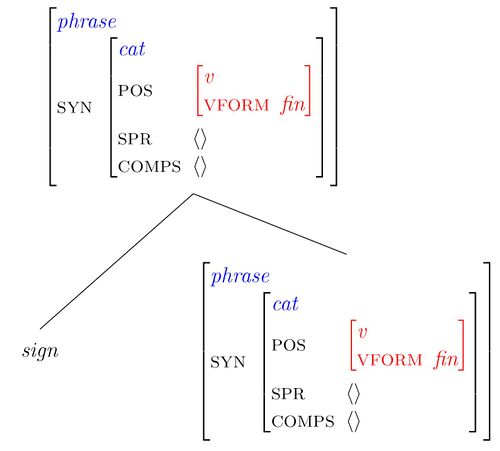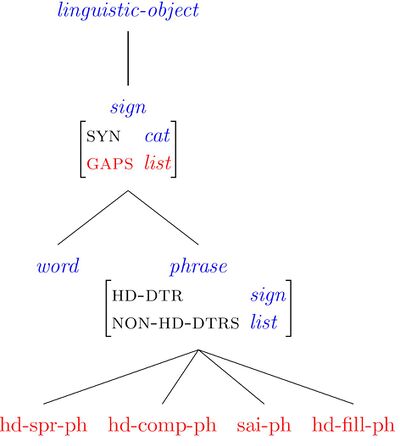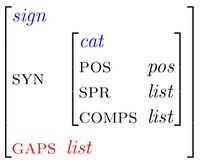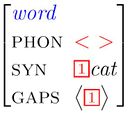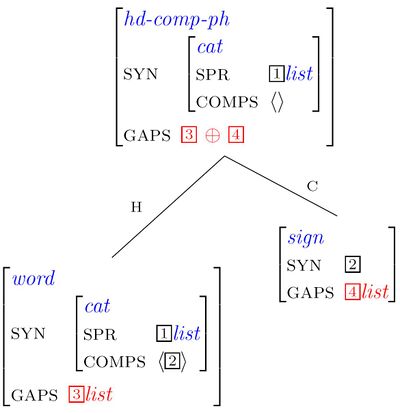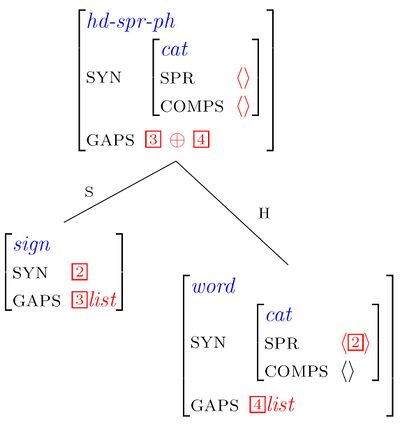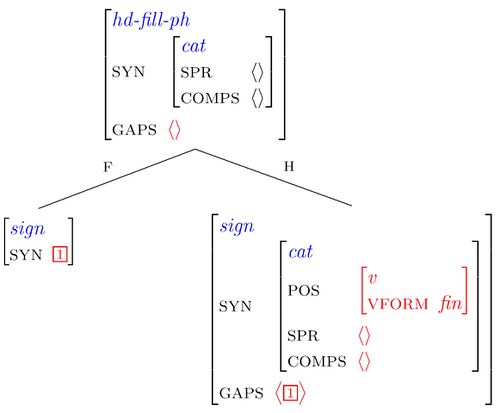Syntax 1 Wiki: Week 8
Step 2 Licensing the extra expression at the beginning of the sentence
The second problem we need to solve in order to license expressions like her she likes is the occurrence of her at the beginning of the sentence. None of the 3 schemas we have available will licence this extra sign at the beginning of a sentence. So, we have no choice but to formulate a new schema. Here it is:
The top node and the second daughter of the schema represent complete finite sentences. The first daugher can be any sign. This schema licenses her as the first daugther of a finite sentence whose second daughter is she likes.
Exercise:
- Go to the Online Grammar 2, which contains the gap and the schema above.
- Parse the following strings:
- him Lilly likes (choose solution 1)
- him Lilly spoke to (choose solution 3)
- to him Lilly spoke (choose solution 4)
This solves the second problem: complete sentences can have an extra sign as their first daughter.
Unfortunately, it is too early to open the champagne
Exercise:
- Go back to the Online Grammar 2, which contains both the gap and the schema above.
- Parse the following strings:
- he Lilly likes (choose solution 1)
- he Lilly spoke to (choose solution 1)
What problem does the grammar output for the sentences above bring into the open?
Check your answer
The grammar licenses
1. sentences with a gap, and
2. sentences with an extra expression at the beginning of the sentence.
The problem is that the grammar does not connect the two phenomena!
Exercise
- Study the following blocks of sentences carefuly and look for a pattern in the data:
(1)
a. Lilly likes him.
a'. Him Lilly likes __.
b. *Lilly likes he.
b'. *He Lilly likes __.
c. *Lilly likes to him .
c'. *To him Lilly likes __.
(2)
a. Lilly depends on him.
a'. Him Lilly depends on __.
b. *Lilly depends on he.
b'. *He Lilly depends on __.
(3)
a. Lilly depends on him.
a'. On him Lilly depends __.
b. *Lilly depends him.
b'. *Him Lilly depends on __.
(4)
a. Lilly said I like him.
a'. Him Lilly said I like __.
b. *Lilly said I like he.
b'. *HeLilly said I like __.
(5)
a. Lilly said I claimed she likes him.
a'. Him Lilly said I claimed she likes __.
a. *Lilly said I claimed she likes he.
a'. *He Lilly said I claimed she likes __.
What pattern do (1)-(5) show?
Check your answer
An expression can be preposed from a position P if and only if it can occur in position P.
Consequence: the gap and the extra expression at the left of the sentence need to be connected!
Introducing the GAPS feature
The last section showed that that not just any extra expression can be added at the left edge of the sentence that contains a gap. Rather, the syntactic category of gap and the extra expressoion must harmonize with each other. When that is the case, we say that the extra expression fills the gap. Such harmony between filler and gap requires that information about the gap must flow within the tree from the gap to the filler. In the following we will make such information folow possible.
First, we add the feature GAP to the type sign which for any sign takes as its value the list of the categories of all the gaps that the sign contains:
Simultaneously, we name every phrase after the syntactic schema that forms it, e.g. hd-comp-phrase, hd-spr-phrase, etc. See the subtypes in red in the portion of the type hierarchy above.
Requiring all signs to have the GAPS feature with value list leads to the following general structure of the type sign:
Since the gap is a sign, it also must have the list-valued GAPS feature. Study the following revised structure of the gap carefully:
The gap has the following interesting property: the gap is the only sign which stores its own syntactic category in its GAPS list. In contrast, all words with a non-empty phonology are not allowed to contain any information in their GAPS lists:
The non-empty GAPS list of the gap serves as the basis for the information flow from the gap to its filler, as we will now show.
The Gap Collection Constraint
Illustrating the Gap Collection Constraint
The Head-filler schema
We distinguish between two kinds of phrases:
1. Stand(ard) phrases: hd-comp-ph, hd-spr-ph, hd-c-ph, sai-ph
2. Head-Filler phrases: top-ph, question
Remarks:
1. ⊕ is the list merger operator. (to merge = verschmelzen)
2. L1 ⊕ L2 is the new list L3 which contains all the elements of list L1 followed by all the elements of list L2.
Examples:
1. <> ⊕ < a > = < a >
2. < a > ⊕ <> = < a >
3. < a, a > ⊕ < a, b, c > = < a, a, a, b, c >
